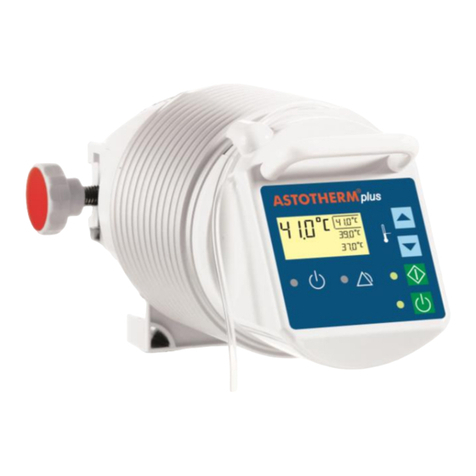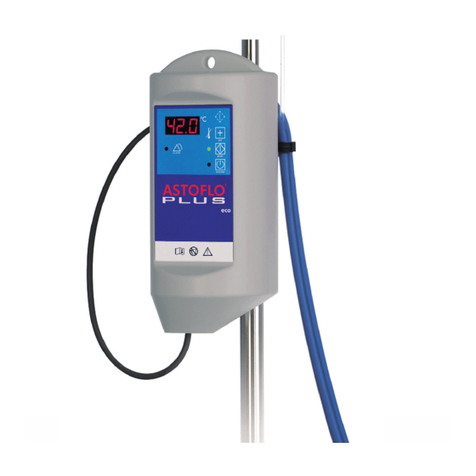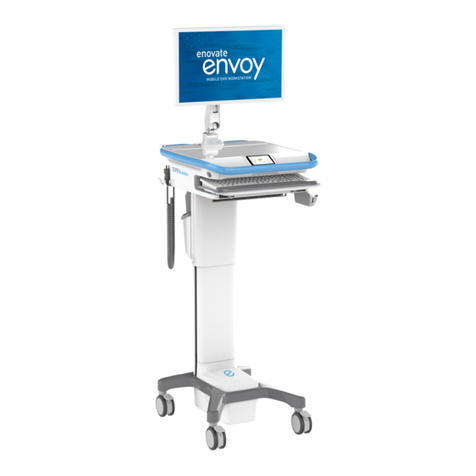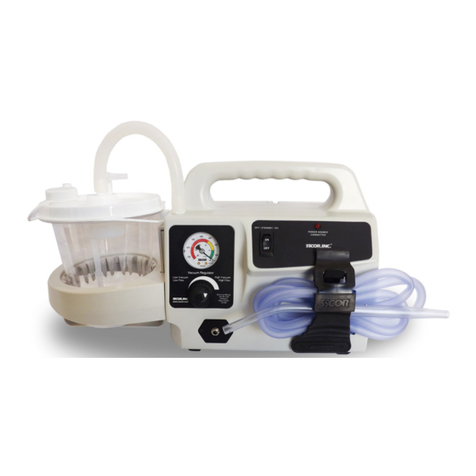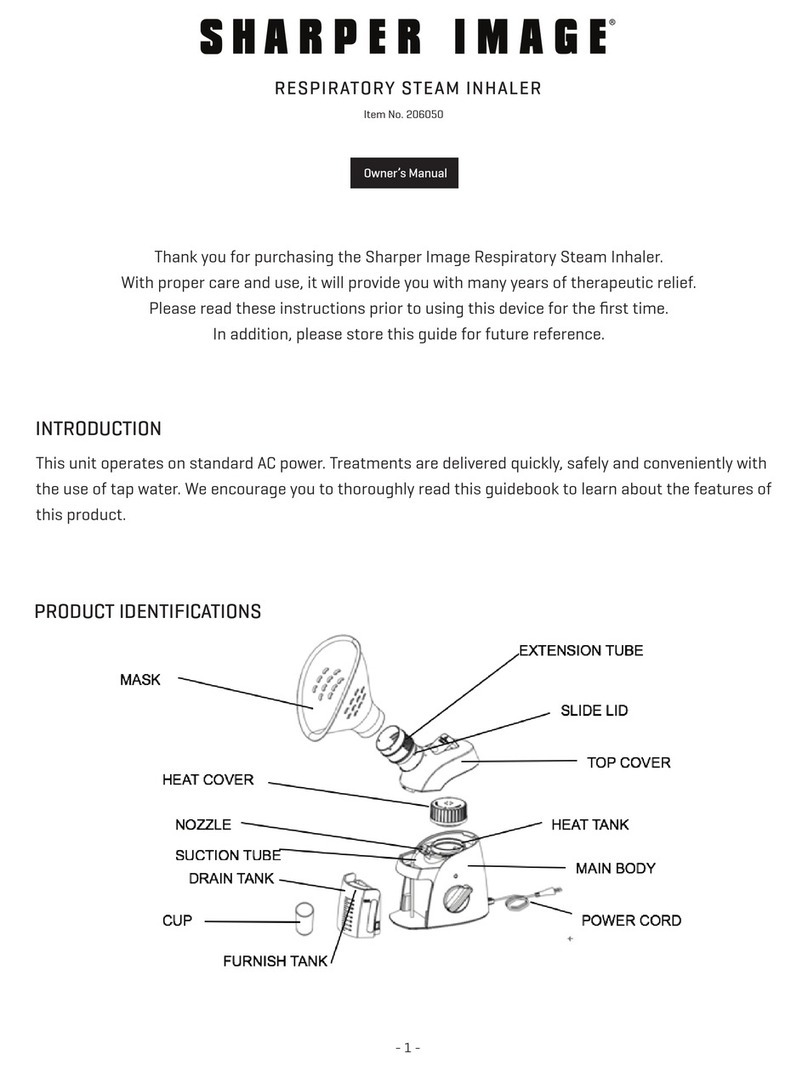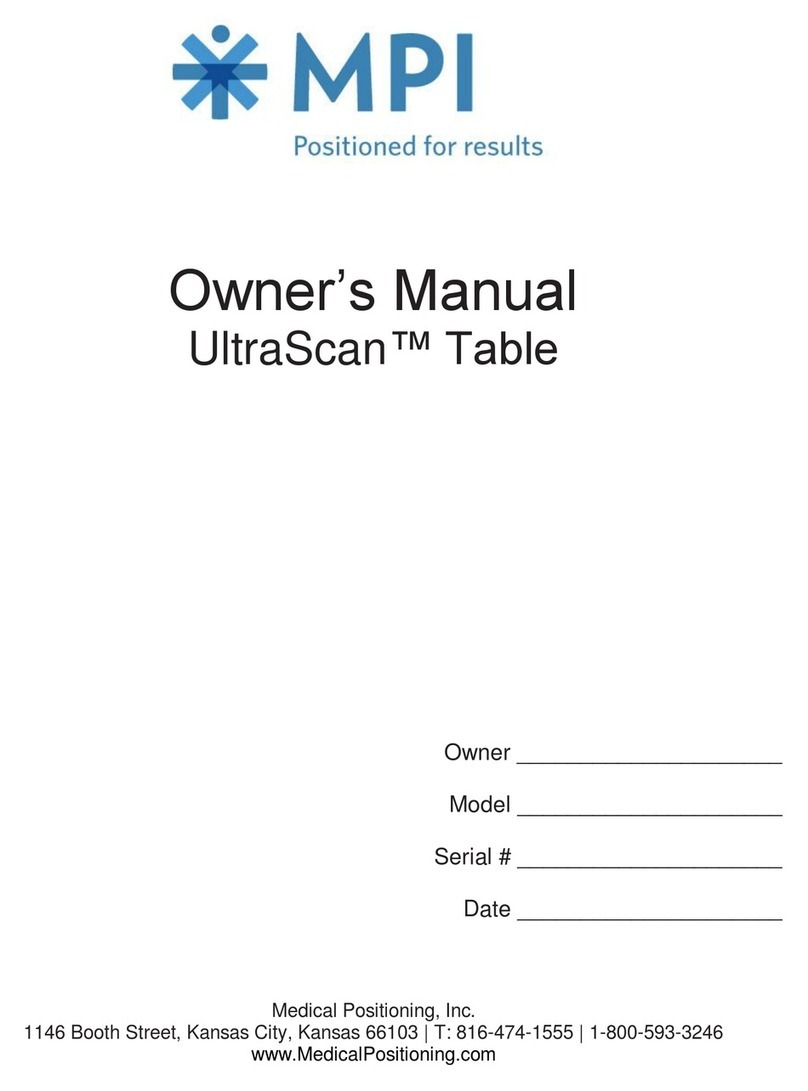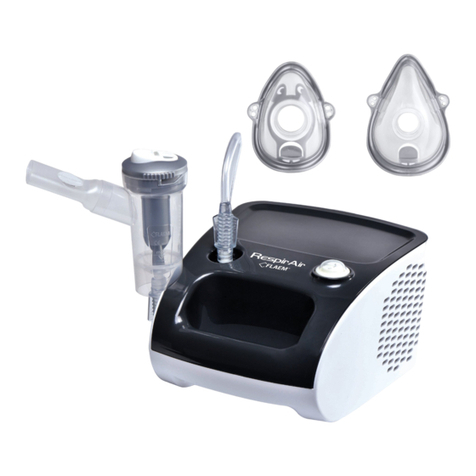STIHLER ELECTRONIC ASTOPAD User manual

Instructions for use
ASTOPAD®
Patient Warming System
STIHLER ELECTRONIC GmbH •70597 Stuttgart •Germany
Part no. 0315.7200.12NA Rev. 01_draft 02/2020

To be completed by the user:
Serial number
Registration number
Device location
Start-up date
Manufacturer:
STIHLER ELECTRONIC GmbH
Julius-Hoelder-Strasse 36
70597 Stuttgart
GERMANY
Tel. +49 (0) 711-720670
Fax +49 (0) 711-7206757
www.stihlerelectronic.de
E-Mail: info@stihlerelectronic.de
© 2020 STIHLER ELECTRONIC GmbH

CONTENTS
1 Information about these instructions ..............................................................5
2 General information...........................................................................................5
2.1 Guarantee conditions..................................................................................................................5
2.2 Liability .......................................................................................................................................5
2.3 Disposal of the equipment...........................................................................................................6
2.4 Information about the Battery......................................................................................................6
2.5 Return of a used product.............................................................................................................6
2.6 Service information.....................................................................................................................7
3 Important safety information............................................................................7
3.1 Dangers......................................................................................................................................7
3.2 Warnings ....................................................................................................................................8
3.3 Cautions ...................................................................................................................................11
3.4 Notices .....................................................................................................................................12
4 Intended Use ....................................................................................................13
4.1 Indications for Use....................................................................................................................13
4.2 Contraindications......................................................................................................................13
4.3 Possible adverse effects...........................................................................................................13
4.4 Intended patient group..............................................................................................................13
4.5 Intended body part....................................................................................................................13
4.6 Intended user profile.................................................................................................................13
4.7 Intended environment of use / operation...................................................................................14
5 Symbols............................................................................................................15
6 Product description.........................................................................................19
6.1 Introduction...............................................................................................................................19
6.2 Technical description................................................................................................................19
6.3 Components of the ASTOPAD..................................................................................................21
6.4 Control panel ............................................................................................................................23
7 Operating states...............................................................................................24
7.1 Standby mode...........................................................................................................................24
7.2 On mode...................................................................................................................................25
7.3 Heating mode output A and/or B...............................................................................................26
7.4 Increasing/decreasing the set temperature ...............................................................................27
7.5 Switching off an output (A or B).................................................................................................28
7.6 Storage/transportation ..............................................................................................................28
8 Installation........................................................................................................29
8.1 Putting into service....................................................................................................................29
8.2 Installation of the Control unit....................................................................................................29
8.2.1 Attachment to infusion stands................................................................................................29
8.2.2 Attachment to medical rails....................................................................................................29
9 Getting started .................................................................................................30
9.1 Preparation for use ...................................................................................................................32
9.2 Starting the heating process .....................................................................................................33
9.3 Selecting a new set temperature...............................................................................................34
9.4 Switching off an output..............................................................................................................34
9.5 Switching off the ASTOPAD......................................................................................................34
9.6 Cleaning and disinfection..........................................................................................................35
10 Alarms and troubleshooting.........................................................................37
10.1 Low temperature alarm “A1”....................................................................................................38
10.2 Overheating alarm “A2”...........................................................................................................39
10.3 Time alarm “A3”......................................................................................................................40
10.4 Overheating alarm shut-off “A4”..............................................................................................41
10.5 Sensor defect alarm “A5”........................................................................................................42
10.6 Heater defect alarm “A6”.........................................................................................................43

ASTOPAD®Instructions for Use
4
11 Information messages and troubleshooting...............................................44
11.1 No applied part connected ......................................................................................................44
11.2 Battery state ...........................................................................................................................44
11.2 Battery defective.....................................................................................................................45
11.3 Applied part temperature too low ............................................................................................45
11.4 Applied part temperature too high...........................................................................................46
12 Brief overview of operating states and alarms...........................................47
12.1 Overview of operating states...................................................................................................47
12.2 Overview of alarms.................................................................................................................49
13 Maintenance ...................................................................................................50
13.1 Recurrents tests......................................................................................................................50
13.2 Replacing the battery..............................................................................................................51
14 Technical data................................................................................................52
15 Conformity with international standards.....................................................55
16 Ordering information and Accessories.......................................................56
17 Guidelines and manufacturer’s declaration................................................57

ASTOPAD®Instructions for Use
5
1 Information about these instructions
•Carefully read the entire instructions for use
before using the device.
•Correct and safe operation can only be guaranteed if the
instructions for use are observed.
•Incorrect use can result in damage to the product or to other
property and/or personal injury.
•Keep the instructions for use for future reference.
•Only use the device for the intended purpose as described in
these instructions for use. Refer to the section “Intended Use”.
2 General information
2.1 Guarantee conditions
The guarantee period is 12 months. During this guarantee period the manufactur-
er will repair or replace free of charge all defects caused as a result of material or
manufacturing errors.
Other damage is not subject to this guarantee. The guarantee does not include
cases of misuse or incorrect handling, use of force, or damage caused by normal
wear and tear. This applies also to changes undertaken by persons who are not
authorized by the manufacturer and to modifications to the original condition.
If the equipment is damaged during the guarantee period, send the cleaned
equipment to the nearest sales point or directly to STIHLER ELECTRONIC
GmbH. The sender is responsible for any transport and packaging costs.
2.2 Liability
The manufacturer is only liable for the safety, reliability and performance of the
equipment
•if all operating, servicing, and calibration procedures have been carried out by
trained and qualified persons according to the procedures published by the
manufacturer;
•if only original spare parts have been used to replace components as needed;
•if assembly and repairs are only carried out by authorized personnel or an
authorized service center;
•if the electrical installations satisfy the locally applicable regulations and the
IEC/EN requirements and
•if the equipment is used for its intended purpose and at a suitable location in
accordance with the instructions for use.

ASTOPAD®Instructions for Use
6
2.3 Disposal of the equipment
Electrical devices are recoverable waste and should not be disposed of in
domestic waste at the end of their service life. Please follow the local rules for the
disposal of used products, or send the cleaned and disinfected equipment with a
corresponding note to STIHLER ELECTRONIC GmbH or your closest sales point.
This will ensure the most cost efficient and proper disposal of your old equipment.
Follow the national regulations on the disposal of medical products.
2.4 Information about the Battery
Batteries must not be disposed of in domestic waste. The user is obliged to carry
out proper disposal. Returns can be made to public communal collection points or
wherever the batteries are sold.
The battery can be removed by loosening the 4 screws on the underside and
opening the housing.
2.5 Return of a used product
A report must be sent together with the equipment, detailing the precise reasons,
circumstances, and, if known, the cause of the return. To prevent transportation
damage, the equipment should be shipped either in the original packaging or in
other, well-protected packaging.
Transport rule for the return of device with built-in battery:
When returning ASTOPAD DUO310 control units, it is essential to ensure that the
control unit is in storage / transport condition (see chapter 7.6 "Storage / transpor-
tation").
WARNING
Risk of infection!
Clean and disinfect the equipment after every use and before you return the
equipment for repairs.
NOTICE
The customer is responsible for the proper packaging and labelling of returns.

ASTOPAD®Instructions for Use
7
2.6 Service information
For service or technical support in United States and Canada, please contact your
local sales point or the following:
Gentherm Medical LLC. Telephone 1-513-772-8810
12011 Mosteller Road Toll Free (U.S.) 1-888-437-5608
Cincinnati, OH 45241 Fax 1-513-772-9119
USA E-Mail medical@genthermcsz.com
Visit our Web Site at www.gentherm.com
Before you call a service …
To help us better serve you, please have the serial numbers of your ASTOPAD
system (control unit & applied part) ready when you call for parts or service. The
serial number is located on the type label attached the control unit’s rear and on
the backside of the junction block of the applied parts.
3 Important safety information
These instructions for use define and refer to the following safety information.
DANGER
DANGER indicates a hazardous situation which, if not avoided, will result in
death or serious injury.
WARNING
WARNING indicates a hazardous situation which, if not avoided, could result in
death or serious injury.
CAUTION
CAUTION indicates a hazardous situation which, if not avoided, could result in
minor or moderate injury.
NOTICE
NOTICE indicates a property damage message.
3.1 Dangers
DANGER
Explosion hazard!
Do not use the ASTOPAD patient warming system in an explosion-hazard
environment or in the presence of flammable anesthetics.

ASTOPAD®Instructions for Use
8
3.2 Warnings
WARNING
Risk of injury!
•ASTOPAD is only to be used under the direction of a Licensed Healthcare
Practitioner.
•Read and observe all instructions, stickers, and accompanying documenta-
tion enclosed with the medical device. Failure to observe the instructions, in-
cluding warnings and safety information, can result in incorrect handling, pa-
tient injury, injury to users or medical personnel, damage to the device, or
material damage.
•Operate and service this equipment only in accordance with the procedures
described in these instructions and with the applicable standards, rules, and
guidelines. The manufacturer shall not be responsible for the safety of users
or patients if any actions/procedures other than those published are carried
out during operation, servicing, or recurrent test.
•This device may only be operated by appropriately trained and medically
qualified healthcare professionals.
•The service personnel must be appropriately trained and qualified.
•If the OR table top is tilted (adjusted through the longitudinal axis), there is a
chance that the patient will slip off. The patient must be sufficiently secured
against slipping before the OR table top is tilted or otherwise moved out of
the horizontal position.
•Due to the physico-chemical properties of disinfectants, ensure that disinfect-
ants do not accumulate beneath the patient. During use, the patient must not
be moist or even wet when lying on the mattress. This presents a chemical
burn hazard.
•When RF surgical instruments or endocardial catheters are used, the patient
must also be properly insulated. This insulation must not be damp. The
equipment manufacturer’s instructions for use must be observed at all times.
•With transdermal drug applications (patches), the additional heat can in-
crease the uptake of the drugs and result in injury to the patient.
•In the case of arterial occlusion, the applied parts of the ASTOPAD may not
be used distal to this area.
•Overheating of ischemic extremities can occur with the use of the ASTOPAD
applied parts.
•The ASTOPAD does not contain any parts the user can repair. Therefore, do
not attempt to repair the ASTOPAD yourself. Contact your local sales point.
•Any repairs to the equipment may only be carried out by persons authorized
and qualified by the manufacturer.
•Modifications to the ASTOPAD are not permitted.

ASTOPAD®Instructions for Use
9
WARNING
Risk of injury!
•When applied parts ASTOPAD COV are used as a top blanket, ensure that
they do not obstruct the patient’s field of vision.
•Do not use the ASTOPAD until the following error conditions have been rem-
edied through appropriate corrective action:
- Damaged or worn cables, plugs, or connecting socket.
- Damaged housing, damaged or loose control panel.
- Damaged or missing markings/safety signs/warnings.
- Damaged outer cover of the applied parts.
- Alarm testing equipment defective. No optical or acoustic alarm after
switching on using the Standby button (self-test).
- Button(s) which do not function correctly.
- A system that has been exposed to mechanical impact or liquid ingress into
internal electronic system components.
- A system that has previously delivered an electric shock to a person.
- A system that appears to be overheating.
- If at least one of the applied parts in a system triggers or has triggered an
alarm shut-off.
- If the self-test does not activate automatically after switching on with the
Standby button and the heater does start operation immediately.
•The extension connection cable and the mains cable should not touch the
patient and should not hinder the treating personnel.
•If the ASTOPAD DUO control unit with installed battery is not used for a
longer period, the battery must be removed.
WARNING
Risk of overheating!
•For pediatrics under 90 cm in length/height,use only the applied part ASTO-
PAD COV070.
•Do not use ASTOPAD COV105 or COV155 or COV180 for pediatrics under
90 cm in length/height.
WARNING
Risk of infection!
•Use aseptic procedures.
•Clean and disinfect the equipment after every use and before you return the
equipment for repairs.
•Route the extension connection cable between the applied part and the con-
trol unit in such a way that it is protected from soiling of blood and body fluids.
•Prevent the cables from coming into contact with the floor.
•It is recommended to always place a waterproof and absorbent barrier be-
tween the patient and the ASTOPAD applied part.

ASTOPAD®Instructions for Use
10
WARNING
Risk of decubitus ulcer!
•Regardless of the treatment duration, aged, paralyzed, comatose, and
cachectic patients are particularly at risk of decubitus ulcers. Critical
points should therefore also be constantly examined by medical personnel.
•Do not fold, bend, or operate the applied parts in a folded condition.
•Do not place the patient on the connection block of the applied part.
•When the ASTOPAD COV applied parts are used as an under-blanket, en-
sure that they are placed flatly underneath the patient, are secured, and will
not crease.
•Care must be taken during any surgical interventions to ensure that sufficient
measures are taken to prevent decubitus ulcers in accordance with the pa-
tient's positioning.
•The risk of skin irritation caused by pooling of surgical prep solutions under
the patient may increase with warming; ensure that surgical prep solution in-
structions for use are followed.
•Alleviate or remove the risk of heating skin under pressurized bony promi-
nences.
•DO NOT place any hard objects (e.g., mattress cables, ECG cables, hard
cautery return pads, patient fluid lines, etc.) between the ASTOPAD applied
part and the patient.
•ASTOPAD COV applied parts can be wrapped around the patient. However,
take care that the applied part will not form creases.
WARNING
Risk of electric shock!
•To avoid the risk of electric shock, this equipment must only be connected to
a supply mains with protective earth.
•Do not use mains adapters that interrupt the earth conductor.
•Do not open the ASTOPAD DUO310 housing.
•If several pieces of equipment are combined or connected together (e.g., in
multiple socket outlets), the total leakage currents must not exceed the allow-
able limits (refer to the respective national regulations). Observe the require-
ments as stipulated in IEC/EN 60601-1 regarding medical electrical systems.
•All electrical installations must conform to the applicable electrical standards
and the specifications defined by the manufacturer.
•Before every use, check to make sure that the ASTOPAD DUO310 control
unit and the applied parts of the ASTOPAD are undamaged.
•The mains plug must be removed from the socket to fully disconnect the
ASTOPAD from the mains.

ASTOPAD®Instructions for Use
11
WARNING
Risk of radio interference!
•Use of this equipment adjacent to or stacked with other equipment should be
avoided because it could result in improper operation. If such use is neces-
sary, this equipment and the other equipment should be observed to verify
that they are operating normally.
•Use of accessories, other than those specified or provided by the manufact-
urer of this equipment could result in increased electromagnetic emissions or
decreased electromagnetic immunity of this equipment and result in improper
operation.
•Portable RF communications equipment (including peripherals such as an-
tenna cables and external antennas) should be used no closer than 30 cm
(12 inches) to any part of ASTOPAD, including cables specified by the manu-
facturer. Otherwise, degradation of the performance of this equipment could
result.
3.3 Cautions
CAUTION
Risk of injury!
•Federal law (USA) restricts this device to sale by or on the order of a Licensed
Healthcare Practitioner.
•When installing the ASTOPAD DUO310 control unit on an infusion stand, ob-
serve the instructions from the infusion stand manufacturer regarding maxi-
mum load and tilting stability.
•When ASTOPAD is used on the OR table, the OR table must be prepared
according to the customary regulations and guidelines.
•Never insert pointed or sharp objects into the applied parts or damage the
surface of the parts in any other way.
•Damage to the Applied part can cause overheating, therefore:
- Do not use bleach solution with hypochlorite for disinfection of the applied parts.
- Other than the cleaning and disinfection procedures described in this IFU shall
not be applied without the manufacturer’s authorization.
•
Do not continue to use ASTOPAD applied parts beyond the labeled Use by Date.
CAUTION
Risk of hypothermia!
•If the alarm shut-off of the ASTOPAD is triggered at an output, the entire system
will switch off.
•If thermally conductive materials, such as water, gel, and similar substances, are
used and were not pre-heated, the patient’s body temperature may reduce as a
result once the ASTOPAD applied parts are switched off.

ASTOPAD®Instructions for Use
12
CAUTION
Risk of hypothermia!
•When the ASTOPAD is used, the patient’s body temperature must be monitored
at regular intervals.
•The temperature control of the ASTOPAD controls and monitors the temperature
of the applied parts, but not the patient’s body temperature.
•If the ASTOPAD cannot be started or if the patient's temperature balance is insuf-
ficient, consider the use of alternative warming methods in order to avoid or re-
duce hypothermia or to improve the patient's well-being.
•When this product is used in combination with other heat sources, an overheating
alarm or an overheating alarm shut-off may occur on the ASTOPAD DUO310
control unit.
CAUTION
Risk of radio interference!
•The essential performance can be lost or degraded due to EM disturbances. As a
result, there is the possibility of hypothermia of the patient.
•According the standard IEC/EN 60601-1-2, medical electrical equipment requires
special precautions regarding electromagnetic compatibility (EMC) and needs to
be installed and put into service according the EMC information provided.
•The device/system can cause radio interferences or can interfere with the opera-
tion of devices in the vicinity. Appropriate measures may be necessary, such as
reorienting or relocating of ASTOPAD or shielding.
3.4 Notices
NOTICE
•The specified humidity protection IPX2 for the ASTOPAD applied parts is
ensured only when the connector
- Is connected to a suitable extension cable
or
- The attached protective cap is used.
•Actions to avoid damaging the patient warming system:
- Do not immerse the control unit and/or the applied parts in liquid.
- Do not disinfect the system using steam (e.g., in autoclaves), hot air, or
thermo-chemical cleaning solutions.
- The applied parts must not be disinfected with bleach solution
(hypochlorite or other agents containing chlorine).
- The operator should not use any cleaning or decontamination methods oth-
er than those recommended by the manufacturer.
•The customer is responsible for the proper packaging and labelling of returns.
•The specified defibrillation protection is ensured only when the applied part is
connected to the extension connection cable and the control unit.

ASTOPAD®Instructions for Use
13
4 Intended Use
The ASTOPAD patient warming system is intended to prevent or treat hypother-
mia and to provide warmth to patients.
4.1 Indications for Use
The ASTOPAD patient warming system is indicated for use in all areas of
healthcare facilities for preventing or treating hypothermia or maintaining normo-
thermia. The warming blankets can be used over or under the patient (pediatric
and adult) by appropriately trained healthcare professionals.
4.2 Contraindications
No contraindications are known for patient warming.
4.3 Possible adverse effects
In normal use, no side effects arising from ASTOPAD are to be expected. For
longer surgical procedures there is an increased pressure ulcer risk for the pa-
tient. To reduce the pressure ulcer risk, therefore, the additional use of a pres-
sure-relieving support is recommended after an operating time of two hours.
4.4 Intended patient group
For pediatrics under 90 cm in length/height use only the ASTOPAD applied part
COV070.
For all other patients (greater than 90 cm in length/height) all available ASTOPAD
applied parts can be used (COV070, COV105, COV155, COV180).
4.5 Intended body part
ASTOPAD applied parts COV are intended for use underneath or over the pa-
tient, partial or complete (torso and extremities on all sites), head (without visual
field).
Control unit, connecting cable and applied parts are not intended for direct skin
contact. A thin waterproof and absorbent barrier shall always be used between
applied part and patient.
4.6 Intended user profile
The device may only be used by qualified medical personnel.

ASTOPAD®Instructions for Use
14
4.7 Intended environment of use / operation
•ASTOPAD may only be used in professional healthcare facilities (e.g. hospital,
emergency care, dialysis, including HF surgical equipment, etc.).
•ASTOPAD is not intended for home healthcare environment.
•ASTOPAD is reusable, but requires cleaning / disinfection between the appli-
cations.
•Appropriate medical hygienic factors must be applied for the use of
ASTOPAD.
•ASTOPAD must not be used in an environment at risk of explosion or in the
present of flammable anesthetics.
•The ASTOPAD can be used in surgical, intensive care or inpatient areas in
which there is a risk of cooling for the patient, or where the patient requires
external warming.

ASTOPAD®Instructions for Use
15
5 Symbols
Symbols and indications on the control panel
The Standby button switches between the Standby mode and the
On mode.
The device is in Standby mode if the blue LED illuminates.
“Start” button: Starts the heating process.
Temperature increase set value.
Temperature decrease set value.
“Stop” button.
Alarm condition when the yellow LED flashes.
No applied part is connected to the control unit.
The applied part heats up to the set temperature.
The applied part cools down to the set temperature.
Battery capacity indicator.
Defective or incorrect battery.
Battery being charged or the device is connected to the mains.

ASTOPAD®Instructions for Use
16
Where applicable, these symbols appear at the appropriate location on the patient
warming system, on the packaging, on the identification plate, or in the accompany-
ing documentation.
Defibrillation-proof type BF applied part in accordance with
IEC/EN 60601-1.
IPX2 Protected against dripping water in accordance with
IEC/EN 60529.
Follow the instructions for use.
Caution: Federal US law restricts this device to sale by or on order
of a Licensed Healthcare Practitioner.
General warning/danger symbol.
Catalogue number.
Serial number.
Batch code.
Year of manufacture.
Manufacturer.
Medical Device
Information for the position of the locking ring on
the cable plug of the extension connection cable.
Battery
Symbol on plug connector for potential equalization in accordance
with IEC/EN 60601-1.

ASTOPAD®Instructions for Use
17
Additional information
Electrical devices are recoverable waste and should not be dis-
posed of in domestic waste at the end of their service life.
Batteries and rechargeable batteries are recoverable waste and
should not be disposed of in domestic waste at the end of their
service life.
Symbol for the permitted temperature range for storage and
transport.
Symbol for the permitted humidity range for storage and
transport.
Symbol for the permitted atmospheric pressure range for storage
and transport.
Transport with the arrows pointing up.
Keep dry.
Fragile, protect against impacts.
Packaging Labeling for the transport of lithium batteries accord-
ing to ADR SV 188 or IATA - DGR International Dangerous
Goods Regulations, Packing Instruction 965, II. SECTION II
43416
Labeling for individual shipment of lithium-Ion batteries via air
freight according to IATA - DGR International Dangerous Goods
Regulations, Packing Instruction 965, II. SECTION II
II.2 Additional requirements 43418 / v4
This device conforms to EC Council Directive 93/42/EEC of
14 June 1993 concerning medical devices. The notified body,
DEKRA Certification GmbH (registration number 0124), monitors
the manufacturer’s quality management system.
75JA
MEDICAL – GENERAL MEDICAL EQUIPMENT AS TO ELEC-
TRICAL SHOCK, FIRE AND MECHANICAL HAZARDS ONLY
IN ACCORDANCE WITH standards ANSI/AAMI ES60601-
1:2005/(R) 2012 and A1:2012, C1:2009/(R)2012 and
A2:2010/(R)2012,
CAN/CSA-C22.2 No. 60601-1:14. Control No. 75JA
Tilt of the OR table top.
Acoustic alarm signal.
No acoustic alarm signal.
yyyy-mm
Use by Date, DO NOT USE AFTER.

ASTOPAD®Instructions for Use
18
Prohibition: Do not clamp – risk of damage and possible
overheating!
Prohibition: Never insert pointed or sharp objects into the applied
parts – risk of damage and possible overheating!
Prohibition: Do not disinfect with hypochlorite solution
Chlorine and peroxides and all other oxidizing disinfectants have
a negative impact on the materials of the applied parts, therefore
the use of such disinfectants is not recommended. The lifetime is
significantly reduced by these disinfectants.

ASTOPAD®Instructions for Use
19
6 Product description
6.1 Introduction
The ASTOPAD Patient Warming System is a thermal regulating system which
includes a connection cable that attaches to reusable conductive warming blan-
kets for patient warming in clinical environments. The system consists of a con-
trol unit (DUO310) and one or optionally two applied parts (warming blankets).
WARNING
Risk of overheating!
•For pediatrics under 90 cm in length/height,use only the applied part ASTO-
PAD COV070.
•Do not use ASTOPAD COV105 or COV155 or COV180 for pediatrics under
90 cm in length/height.
6.2 Technical description
The ASTOPAD control unit (DUO310) is equipped with a universal mounting
clamp for attaching to standard medical equipment rails or an infusion stand, two
outputs for connecting one or two applied parts, connection to mains by detacha-
ble power supply cord, connector for potential equalization, the electronic boards
and the control panel for the user/operator.
The control unit has two outputs (connecting sockets) A and B for connecting
ASTOPAD applied parts. The desired set temperature can be selected in the
range of 32.0 °C - 39.0 °C in 0.5 °C increments for each connected applied part,
independently of each other, on the control panel of the control unit. The control
unit can also be used with only one of the outputs, A or B. The selected set tem-
perature and the current temperature are displayed individually for each applied
part in the control panel.
The control unit supplies the applied part(s) with electrical current (low voltage)
and monitors and controls the temperature of the applied part(s). When error
conditions occur, the control unit draws the operator's attention to the error condi-
tion by means of alarm signals (optical & acoustical). In the event of failure condi-
tions (overheating, heater defect, sensor defect), the control unit reacts immedi-
ately by shutting off the power supply to the applied part.
Optionally the control unit can be fitted with a battery. When the battery is in-
stalled, it is possible to operate the device independently from the mains for ap-
proximately two hours.

ASTOPAD®Instructions for Use
20
The ASTOPAD DUO310 control unit does not control and indicate the actual
temperature of the patient, but rather only the actual temperature of the applied
part.
Temperature regulation of the individual applied parts is performed with several
integrated sensors.
Safety of ASTOPAD is guaranteed by the following measures per output:
•Several temperature sensors for each applied part
•Double independent sensor monitoring
•Heater monitoring
•Time shut-off
•Visual and acoustic alarm signals
•Overheating and low-temperature alarm if the contact surface tempera-
ture deviates from the temperature controller setting
Table of contents
Other STIHLER ELECTRONIC Medical Equipment manuals
Popular Medical Equipment manuals by other brands
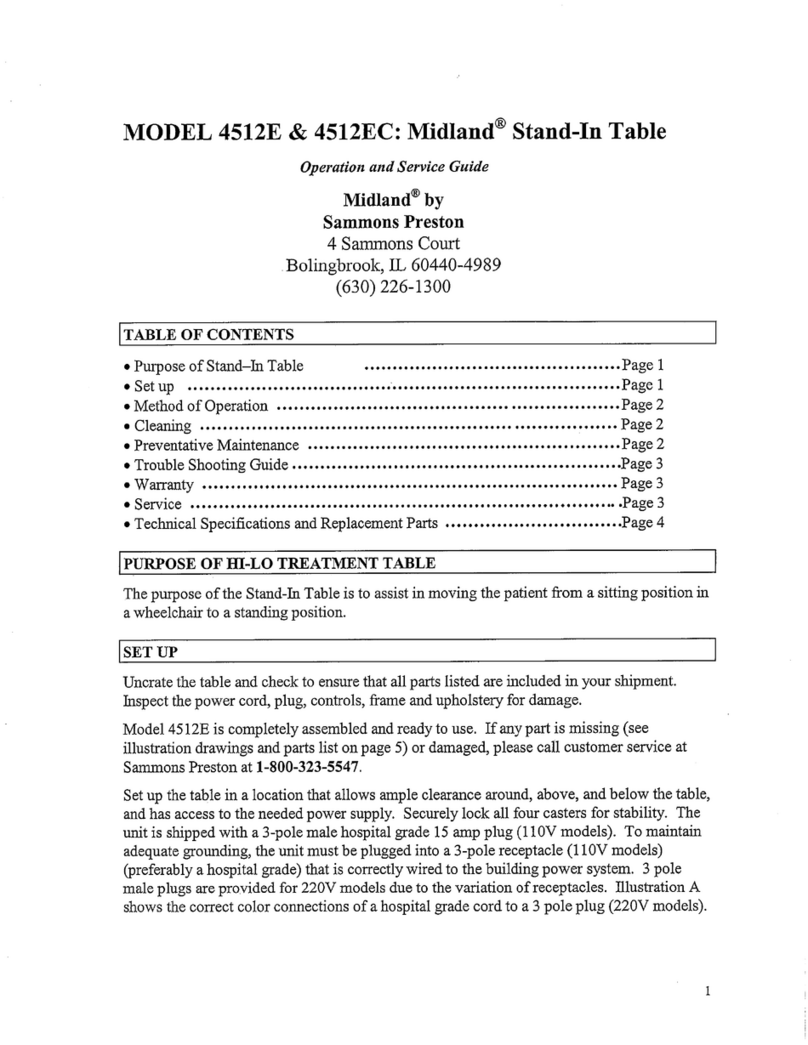
Patterson Medical
Patterson Medical Midland 4512E Operation and service guide
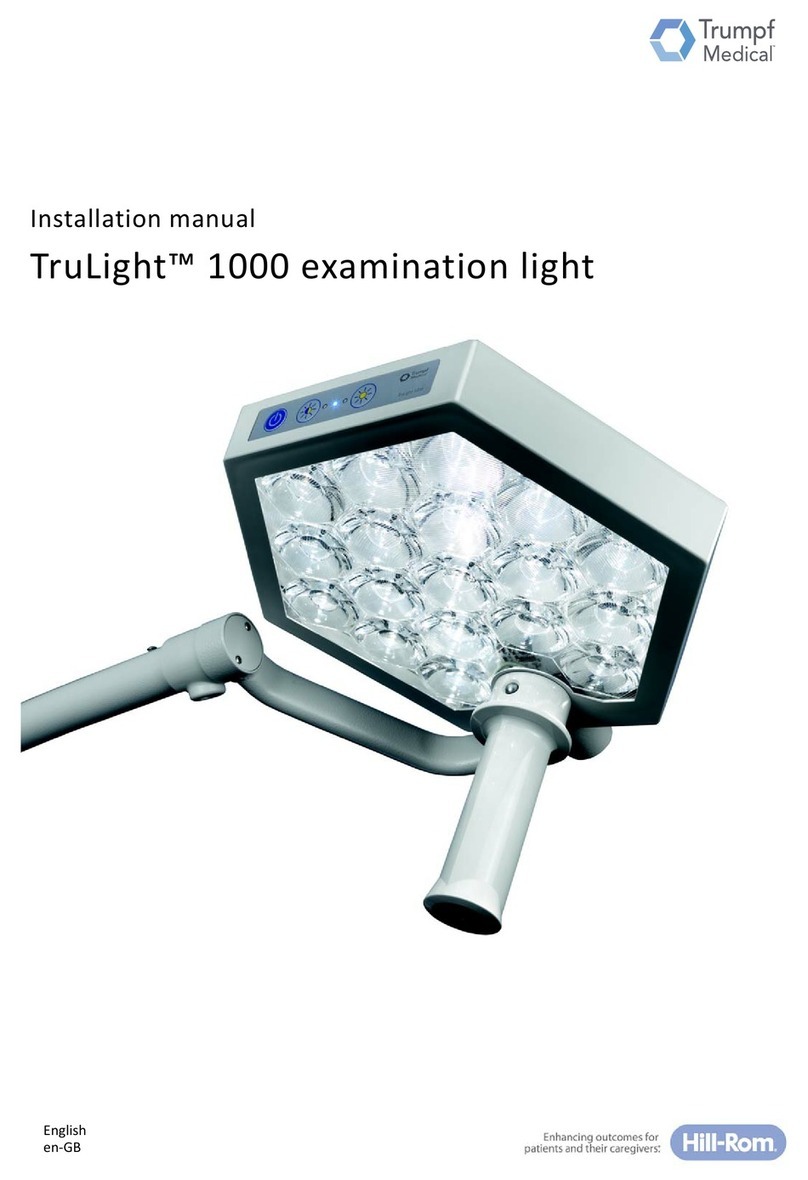
Trumpf
Trumpf TruLight 1000 installation manual
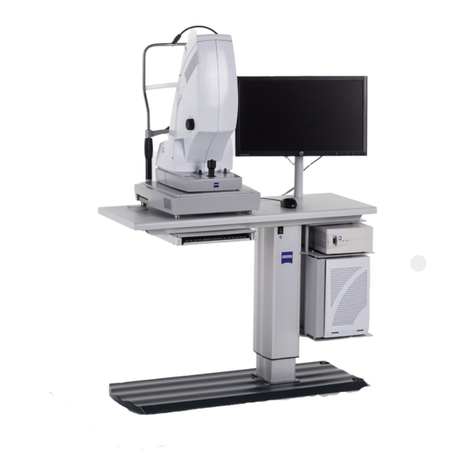
Zeiss
Zeiss CIRRUS 600 Quick reference guide
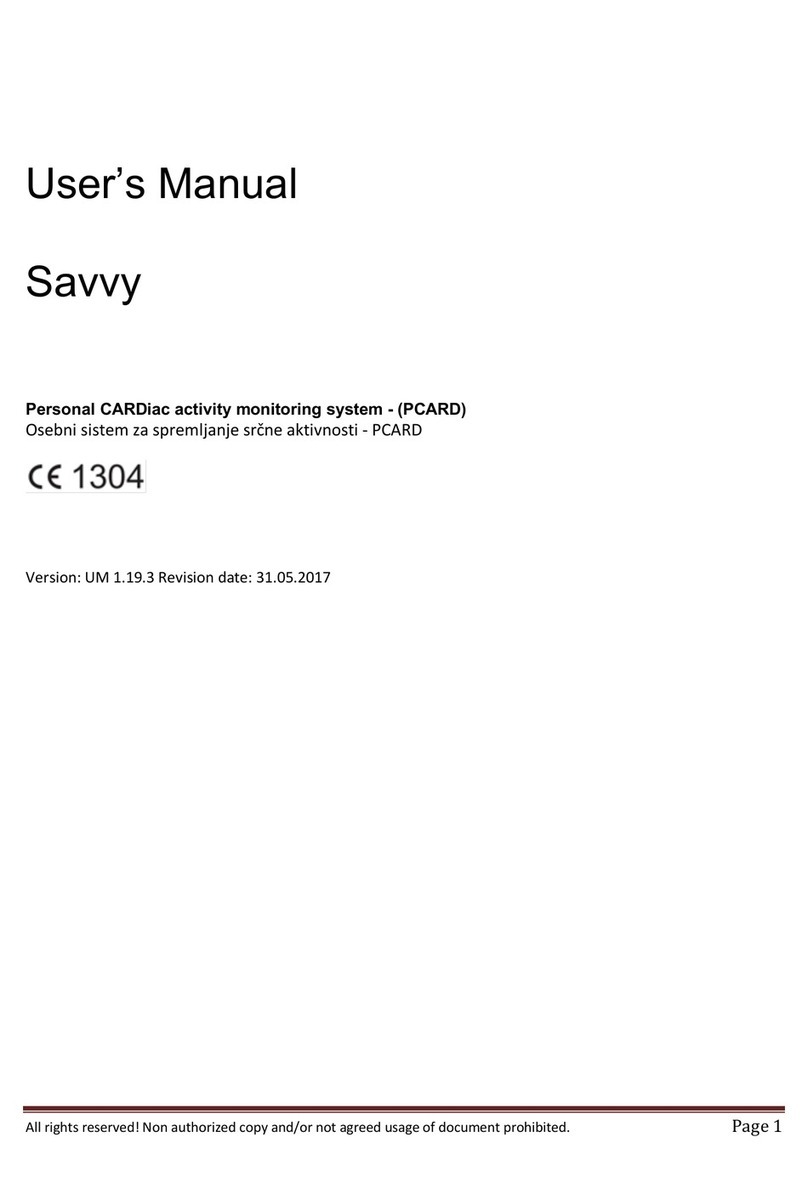
SAVING
SAVING Savvy ECG user manual
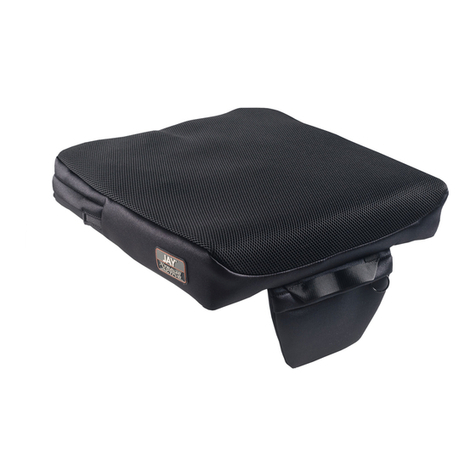
Sunrise Medical
Sunrise Medical Jay Active User instruction manual & warranty

GE
GE MRIaudio 1505 Installation and user guide
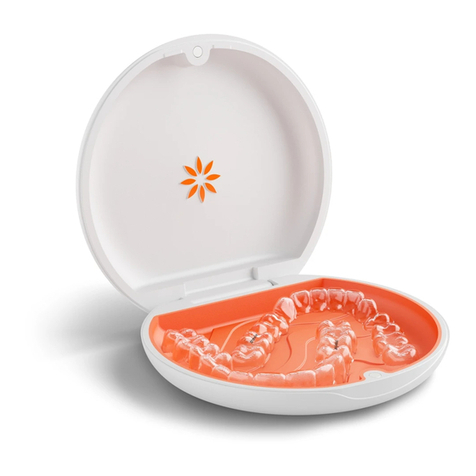
Align Technology
Align Technology Vivera Use and care instructions
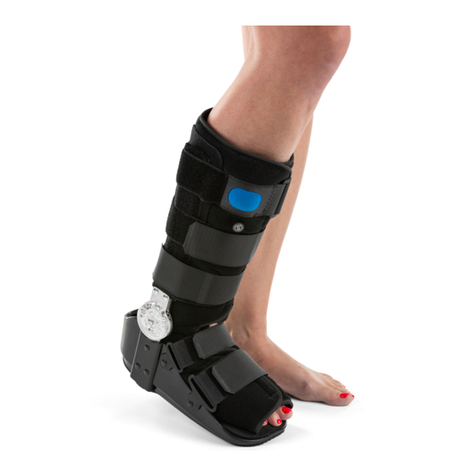
Timago
Timago Air ROM walker user manual
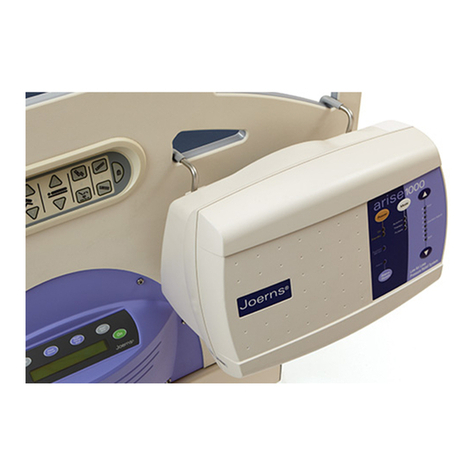
Joerns Healthcare
Joerns Healthcare arise1000 User & service manual
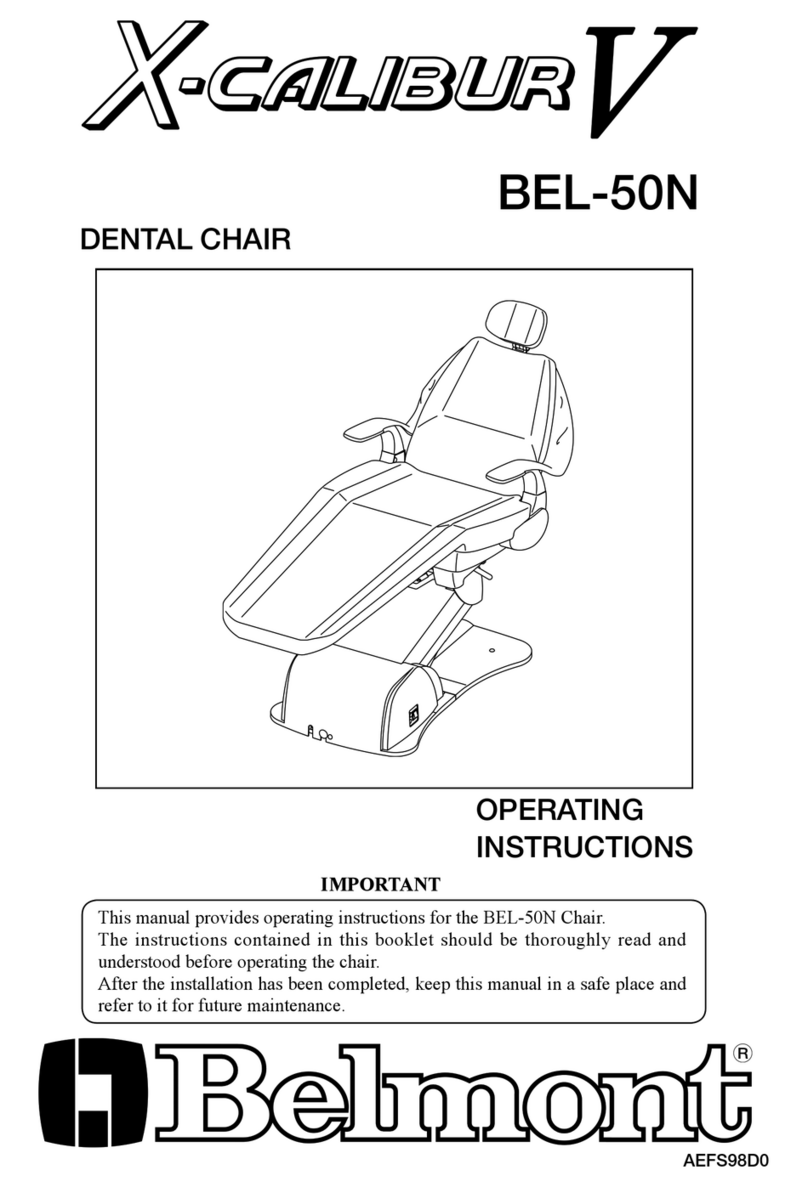
Belmont
Belmont X-Calibur V BEL-50N operating instructions
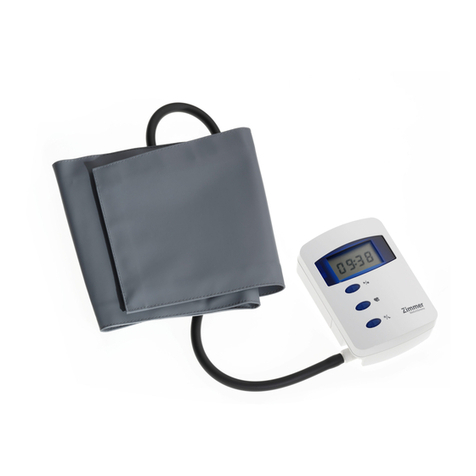
Zimmer
Zimmer PremoPortFour Instructions for use

Ossur
Ossur Miami Jr Instructions for use
